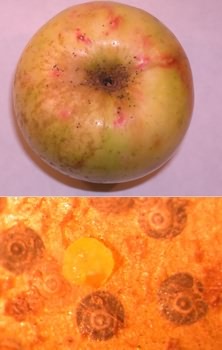Pests
Quadrapidiotus perniciosus Comst. - San Jose Scale, Chinese Scale, Pernicious Scale
Systematic position.
Class Insecta, order Homoptera, suborder Coccoidea, family Diaspididae, genus Diaspidiotus Berl. et Leon.Synonyms.
Diasspidiotus perniciosus Comst., Aspidiotus perniciosus Comst., Comstockaspis perniciosus Comst., Aonidiella perniciosus Comst., Comstockiella perniciosus Comst..Biological group.
Pest of fruit crops.Morphology and biology.
Body of adult female is lemon-yellow. It is covered with rounded dark-gray scale with 2 larval exuviae in the center. Diameter of the scale is 1.5-2 mm. Viviparous species. During the 2 months of its life the female gives birth to 150-200 crawlers having yellowish color. Body of the crawler distinctly segmented, with long suctorial beak, with antennae, eyes and 3 pairs of legs. Body length is 0.25-0.3 mm. Crawlers gather under female's scale during bad weather. They fix to plant by suction after settling; and their body becomes covered with fluff, transforming later into scale. The 1st molt occurs in 8-12 days; as a result of molt, the antennae, eyes and legs reduce. Adult female appears after the 2nd molt. Male nymph development includes 4 stages. The male nymph is distinguished from female by elongate-oval shape of scale. Adult male is light-orange, with 2 wings. Its life lasts only a few hours. The 1st instar nymph hibernates. It has larger black scale.Distribution.
This species originated in the Far East of Russia, NE China, and Northern part of Korean peninsula. It was introduced together with host plants to Europe, Northern and Southern America, Africa, Asia, Australia, Tasmania, New Zealand, Hawaii. In the former USSR it is distributed in Moldavia, Ukraine, Crimea, the Caucasus, Amur Region, Khabarovsk and Primorskii Territories, south of Sakhalin, Kuril Islands, Kazakhstan, Turkmenistan, Uzbekistan and Tajikistan.Ecology.
This species inhabits territories with temperate and subtropical climates. About 200 species of host plants are known, belonging to deciduous trees and bushes. The pest infests trunks, twigs, leaves, and fruits. Females dominate the leafstalks and fruits, but males dominate the leaves. The species is monovoltine in the northern part of area and in the Far East, bivoltine (rarely trivoltine) in southern strip of the European part, 3-4-voltine in Transcaucasia and Tajikistan. In the West Caucasus about 7-18% nymphs of the 1st generation and 40-50% of the 2nd generation enter a winter diapause. During hibernation the nymphs survive at temperature -42°C. Their awakening after winter diapause coincides with blossoming of buds. In nature population density depends on the activity of entomophages, e.g., parasites Prospaltella perniciosi Town., Aphytis proclia Wlk., and predators Chilocorus bipustulatus L., Ch. renipustulatus Scriba.Economic significance.
It is an object of interior quarantine. It is a pest of apple, pear, plum, peach, blackthorn, currants mainly, and cherry and quince to a lesser degree. Apple yield losses reach 15-100%. During high infestation the bark of trunk and branches is covered with cracks, and plants survive poorly during frost. Saplings usually die 3 years after infestation. Red spots appear on infested fruits of apple and pear. Interior quarantine and disinfection of planting stock are important control measures. Prospaltella perniciosi is used for biological control of D. perniciosus. Pheromone traps are used for pest monitoring.Reference citations:
Batiashvili I.D. 1965. Pests of continental and subtropical fruit crops. Tbilisi: Ganatleba. 336 p. (In Russian)Borkhsenius N.S. 1949. Suborder Coccoidea. In: Pavlovskii E.N., Shtakelberg A.A., eds. Pest Animals of Middle Asia (handbook). Moscow-Leningrad: AN SSSR. 220-222 p. (In Russian)
Borkhsenius N.S. 1966. Catalogue of the armored scale insects (Diaspidoidea) of the world. Moscow-Leningrad: Nauka. 449 p. (In Russian)
Borkhsenius N.S. 1973. Practical key to Coccoidea of cultural and forest plants in the USSR. Leningrad: Nauka. 311 p. (In Russian)
Danzig E.M. 1984. Suborder of Coccinea. In: Kopaneva L.M., ed. Keys to harmful and useful insects and mites on fruit and berry crops in the USSR. Leningrad: Kolos. 288 p. (In Russian)
Kirichenko A.N., ed. 1937. The San Jose Scale in conditions of the USSR. Moscow-Leningrad: Sel'khozgiz. 272 p. (In Russian)
Kryzhanovskii O.L., ed. 1972. Pest insects and mites of agricultural plants. Hemimetabola. V. 1. Leningrad: Nauka. 323 p. (In Russian)
Pilipyuk V.I. 1971. San Jose scale in Sakhalin and Kuril Islands. Zashchita rastenii, 7: 43-44. (In Russian)
Ryabtseva N.I., Shutova N.N. 1954. San Jose Scale in Tajikistan and control measures. Stalinabad: Tadjikgosizdat. 38 p. (In Russian)
Savkovskii P.P. 1976. Atlas of the pests of fruit and berry plants. Kiev: Urozhai. 207 p. (In Russian)
Shutova N.N. 1973. Ecological conditions for development of the San Jose Scale in the USSR. Proceedings of the Central Research Laboratory of Plant Quarantine, 1. Moscow. 20-27 p. (In Russian)
Smolyannikov V.V. 1973. San Jose Scale in the USSR. Proceedings of the Central Research Laboratory of Plant Quarantine, 1. Moscow. 1-19 p. (In Russian)
Talitskii V.I. 1954. Diaspididae and Coccidae - pests of fruiters in Moldavia. Kishinev: Gos. Izd. 46 p. (In Russian)
Vasil'ev V.P. 1955. Pests of orchards. Kiev: AN Ukr. SSR. 265 p. (In Russian)
Vasil'ev V.P., ed. 1973. Pests of agricultural crops and forest plantations. V. 1. Kiev: Urozhai. 496 p. (In Russian)


